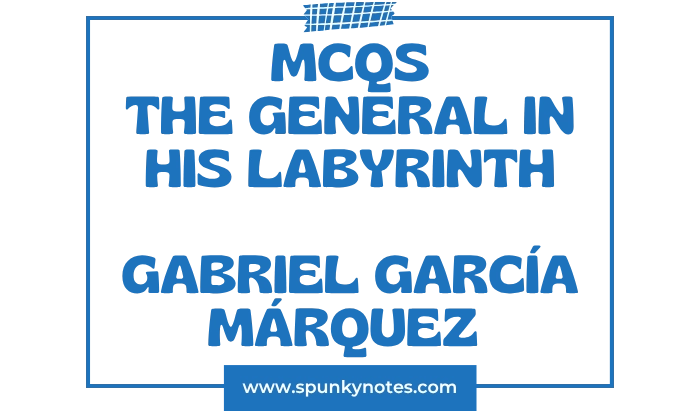

Estimated Reading Time: 17 min
The General in His Labyrinth MCQs
1. What servant found the General floating naked in his bath?
A. Colonel Wilson
B. José Palacios
C. General Montilla
D. Fernando
2. On what date did the General plan to leave Santa Fe de Bogotá?
A. July 24, 1829
B. May 8, 1830
C. September 25, 1828
D. June 16, 1830
3. How old was the General in July of the previous year?
A. Fifty-one
B. Forty-seven
C. Forty-six
D. Thirty-two
4. What did the General use to polish his perfect teeth?
A. Silver paste
B. Charcoal powder
C. Toothbrush
D. White sediment
5. Who was tasked with keeping the General informed of events in his absence?
A. Úrsula Iguarán
B. José Palacios
C. Manuela Saenz
D. General Urdaneta
6. What book was Manuela Saenz reading to the General the night before he left?
A. Rousseau’s Emile
B. Lima News and Gossip
C. The Art of War
D. Social Contract
7. What caused the General’s intense attack of coughing the night before departure?
A. The icy winds
B. Graveyard flowers
C. Lima’s gossip
D. Chronic fever
8. What was the most significant flaw noted about the General’s intended departure?
A. Lack of gold
B. No destination
C. Lack of a passport
D. Too many aides
9. After the failed assassination attempt, how long did the General spend hiding under a bridge?
A. Six days
B. Six hours
C. Two days
D. One night
10. What French manual did the General use for self-diagnosing his ailments?
A. La médecine à votre manière
B. The General’s Health
C. Almanach Hachette
D. Donostierre’s Guide
11. What achievement occurred while the General was presumed dying in Pativilca?
A. Victory at Ayacucho
B. Founding Bolivia
C. Conquering at Junín
D. End of war
12. Who was the shy, superstitious Field Marshal of Ayacucho?
A. General Páez
B. Field Marshal Sucre
C. General Urdaneta
D. General Flores
13. What political rival did the General praise as “the worthiest of generals”?
A. General Urdaneta
B. Field Marshal Sucre
C. Don Joaquin Mosquera
D. General Páez
14. What was the General’s oldest memory, revealed for his intended memoirs?
A. Shipwreck dream
B. Black mule dream
C. Manuela’s love
D. Santa Fe departure
15. What degrading nickname was hurled at the General by crowds?
A. The Generalissimo
B. The Madman
C. Skinny Shanks
D. Old Man
16. Who was elected President of the Republic by Congress?
A. General Urdaneta
B. Don Joaquin Mosquera
C. Domingo Caycedo
D. Francisco Santander
17. What did the General carry in his small knapsack?
A. Gold medals
B. Two Napoleon books
C. Vicuña poncho
D. His spectacles
18. What reason was maliciously suggested for Sucre’s absence at the departure?
A. Was in Venezuela
B. Was not informed
C. Was resentful
D. Was ill
19. How many armed uprisings did the General organize and lose during his career?
A. Thirty-two
B. None
C. Seventeen
D. Five
20. What did the General refer to as “my crises of dementia”?
A. Feverish nightmares
B. Assassination attempts
C. Political failures
D. His rants
21. What kind of animal did the General buy and free in San Juan de Payara?
A. A horse
B. A fighting cock
C. A beautiful mulatta slave
D. A greyhound
22. Who did the General secretly refer to as “Cassandra”?
A. Manuela Saenz
B. General Urdaneta
C. Field Marshal Sucre
D. General Santander
23. Who was killed in the General’s bed during the September 25 plot?
A. Colonel Fergusson
B. Félix Amestoy
C. Captain Ibarra
D. José Palacios
24. What powerful symbol did the General send Miranda Lyndsay upon leaving?
A. A gold sword
B. A reliquary
C. A new horse
D. A pistol
25. What river was the General navigating on traditional barges?
A. Orinoco River
B. Magdalena River
C. Arauca River
D. Apure River
26. Who was Fernanda Barriga, the General’s cook?
A. A Spanish nun
B. A Quitenia Indian
C. A Jamaican slave
D. A French chef
27. What gold item, forgotten for years, did the General find in Mompox?
A. Gold flatware
B. A gold sword
C. Joséfa Sagrario’s cuirass
D. A gold pistol
28. What was General Carcamo’s final observation about their shared memories?
A. Was a comfort
B. Were a burden
C. Were eternal
D. Were false
29. What was the General’s fiery retort to the French pundit’s political advice?
A. Mind your own business!
B. Europe is failing!
C. Let us have our Middle Ages!
D. We choose anarchy!
30. How many armed uprisings did Colonel Aureliano Buendía organize and lose?
A. Thirty-two
B. None
C. Seventeen
D. Twelve
31. What did the General suspect Santander of stealing with English loans?
A. Gold bullion
B. National documents
C. Silver flatware
D. National independence
32. What was the General’s response when told Manuela Saenz was staying behind?
A. I love her dearly.
B. She’s always stayed behind!
C. She must leave now.
D. Her ruin is mine.
33. What was the General’s confession about being in love?
A. It is glorious
B. Like a disaster
C. Like having two souls
D. Totally consuming
34. How many armed uprisings did the General organize?
A. Thirty-two
B. Many
C. Zero
D. Five
35. What was the General’s view on civil wars?
A. Are like killing your mother
B. Are necessary
C. Must be won quickly
D. Are professional hazards
36. Who did the General accuse of leading the assassination of Sucre?
A. General Páez
B. General Obando
C. General Urdaneta
D. General Montilla
37. What was the physical signal of the General’s decline noted by Montilla?
A. His constant cough
B. His gray hair
C. His loss of height
D. His trembling hands
38. What was the symbolic date chosen for the expulsion of Venezuelan officers to fight?
A. September 25
B. May 8
C. July 24
D. December 17
39. What was the General’s presentiment regarding his next birthday, July 24?
A. He would be crowned
B. He would be safe from death
C. He would retire
D. He would regain power
40. What did the General use to cover his freshly shaved head?
A. Gold crown
B. Red Hood
C. Battle helmet
D. Viceroy’s wig
41. What did the General ask Montilla to send him to expel bile?
A. Donkey’s milk
B. Herbal tea
C. Seasickness
D. A German doctor
42. Where did the General decide to live after leaving Montilla’s humid house in Cartagena?
A. A poor suburb
B. La Popa Hill
C. San Carlos Palace
D. La Magdalena
43. What historical event was associated with the smell of hot molasses at San Pedro Alejandrino?
A. His first battle
B. His wife’s death
C. San Mateo Plantation
D. The liberation
44. What caused the General’s birth into history, ending his dream of domestic happiness?
A. The war’s start
B. His wife’s death
C. Napoleon’s coronation
D. Santander’s betrayal
45. What object found in his bedroom in Mompox and San Pedro Alejandrino perplexed visitors?
A. A gold sword
B. An octagonal clock
C. A portrait
D. A silver razor
46. Why did General Montilla break his hand while visiting the General?
A. During a fight
B. In a riding accident
C. In a military exercise
D. In frustration over the news
47. Who did the General dictate his last will to first?
A. General Montilla
B. José Laurencio Silva
C. Fernando
D. José Palacios
48. What did the General ask Colonel Wilson to write to General Justo Briceño in his last days?
A. Repay debt
B. Return home
C. Make peace with Urdaneta
D. Continue the war
49. How many years did José Palacios survive the General?
A. None
B. Seven
C. Many
D. Fifteen
50. What final thought did the General express when facing his impending death?
A. Where is Sucre?
B. The people hate me.
C. How will I get out?
D. I die in peace.
Brief Overview
The General in His Labyrinth is a novel by Gabriel García Márquez, published in 1989. The story is a fictionalized account of the last journey and final days of the historical figure Simón Bolívar, known as “The Liberator.”
The novel recounts Bolívar’s final journey, beginning in May 1830 in Santa Fe de Bogotá. The General is old, extremely sick, and disillusioned. Feeling unloved and stripped of his power, he decides to leave South America for Europe.
His small group, including his loyal servant, José Palacios, travels with him. Health issues and constant political worries plague Bolívar. He is leaving because Congress took away his authority, and people wrongly accuse him of seeking a crown and plotting assassinations.
As he travels down the Magdalena River, he suffers greatly. He receives the devastating news that his trusted friend and intended successor, Field Marshal Sucre, has been murdered. This news causes Bolívar immense rage and distress.
He finally reaches Santa Marta, planning to sail to Europe. However, he cancels the trip and moves to a farm called San Pedro Alejandrino. He is dying of illness and profound sorrow. In his final days, he realizes that his dream of a unified America is wholly lost. He dies poor and alone.


